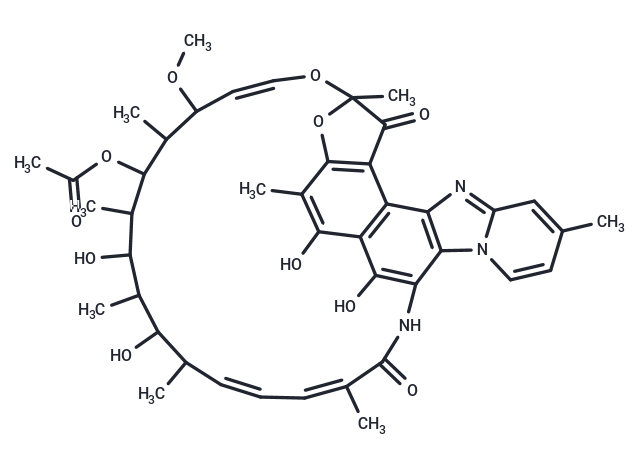Shopping Cart
Remove All Your shopping cart is currently empty
Your shopping cart is currently empty
Rifaximin is an orally administered, semi-synthetic, nonsystemic antibiotic derived from rifamycin SV with antibacterial activity. Rifaximin binds to the beta-subunit of bacterial DNA-dependent RNA polymerase, inhibiting bacterial RNA synthesis and bacterial cell growth.

| Pack Size | Price | USA Warehouse | Global Warehouse | Quantity |
|---|---|---|---|---|
| 200 mg | $31 | In Stock | In Stock | |
| 500 mg | $53 | In Stock | In Stock | |
| 1 g | $81 | - | In Stock | |
| 1 mL x 10 mM (in DMSO) | $57 | In Stock | In Stock |
| Description | Rifaximin is an orally administered, semi-synthetic, nonsystemic antibiotic derived from rifamycin SV with antibacterial activity. Rifaximin binds to the beta-subunit of bacterial DNA-dependent RNA polymerase, inhibiting bacterial RNA synthesis and bacterial cell growth. |
| In vitro | Rifaximin exhibits broad-spectrum activity against aerobic and anaerobic Gram-positive and Gram-negative microorganisms.Rifaximin exhibits a low MIC against Gram-positive bacteria, with a dose range of 0.01 μg/mL to 0.5 μg/mL for MIC 90.Rifaximin binds to the β-subunit of the bacterial DNA-dependent RNA polymerase and inhibits the start of the chain of RNA synthesis. Rifaximin inhibits LPS-induced cytokine and chemokine expression by inhibiting NF-κB DNA binding activity.50 μM Rifaximin reduces changes in pro-inflammatory factor production induced by LPS stimulation in the IEC, such as TNF-α, IL-8, Rantes, and PGE2 in normal intestinal epithelial cells.100 μM Rifaximin is also shown to inhibit LPS-induced cytokine expression by inhibiting NF-κB DNA binding activity. μM Rifaximin effectively reduced the expression of TNFα, IL-8, MIP-3α and RANTES by lipopolysaccharide-induced stimulation. |
| In vivo | Rifaximin exhibits broad-spectrum activity against aerobic and anaerobic Gram-positive and Gram-negative microorganisms.Rifaximin exhibits a low MIC against Gram-positive bacteria, with a dose range of 0.01 μg/mL to 0.5 μg/mL for MIC 90.Rifaximin binds to the β-subunit of the bacterial DNA-dependent RNA polymerase and inhibits the start of the chain of RNA synthesis. Rifaximin inhibits LPS-induced cytokine and chemokine expression by inhibiting NF-κB DNA binding activity.50 μM Rifaximin reduces changes in pro-inflammatory factor production induced by LPS stimulation in the IEC, such as TNF-α, IL-8, Rantes, and PGE2 in normal intestinal epithelial cells.100 μM Rifaximin is also shown to inhibit LPS-induced cytokine expression by inhibiting NF-κB DNA binding activity. μM Rifaximin effectively reduced the expression of TNFα, IL-8, MIP-3α and RANTES by lipopolysaccharide-induced stimulation. |
| Molecular Weight | 785.88 |
| Formula | C43H51N3O11 |
| Cas No. | 80621-81-4 |
| Smiles | COC1\C=C/OC2(C)OC3=C(C2=O)C2=C(C(O)=C3C)C(O)=C(NC(=O)\C(C)=C/C=C\C(C)C(O)C(C)C(O)C(C)C(OC(C)=O)C1C)C1=C2N=C2C=C(C)C=CN12 |
| Relative Density. | 1.36 g/cm3 (Predicted) |
| Storage | store at low temperature,keep away from direct sunlight | Powder: -20°C for 3 years | In solvent: -80°C for 1 year | Shipping with blue ice/Shipping at ambient temperature. | |||||||||||||||||||||||||||||||||||
| Solubility Information | DMSO: 50 mg/mL (63.62 mM), Sonication is recommended. Ethanol: 3 mg/mL (3.82 mM), Sonication is recommended. | |||||||||||||||||||||||||||||||||||
| In Vivo Formulation | 10% DMSO+40% PEG300+5% Tween 80+45% Saline: 2.5 mg/mL (3.18 mM), Sonication is recommended. Please add the solvents sequentially, clarifying the solution as much as possible before adding the next one. Dissolve by heating and/or sonication if necessary. Working solution is recommended to be prepared and used immediately. The formulation provided above is for reference purposes only. In vivo formulations may vary and should be modified based on specific experimental conditions. | |||||||||||||||||||||||||||||||||||
Solution Preparation Table | ||||||||||||||||||||||||||||||||||||
Ethanol/DMSO
DMSO
| ||||||||||||||||||||||||||||||||||||
| Size | Quantity | Unit Price | Amount | Operation |
|---|

Copyright © 2015-2025 TargetMol Chemicals Inc. All Rights Reserved.